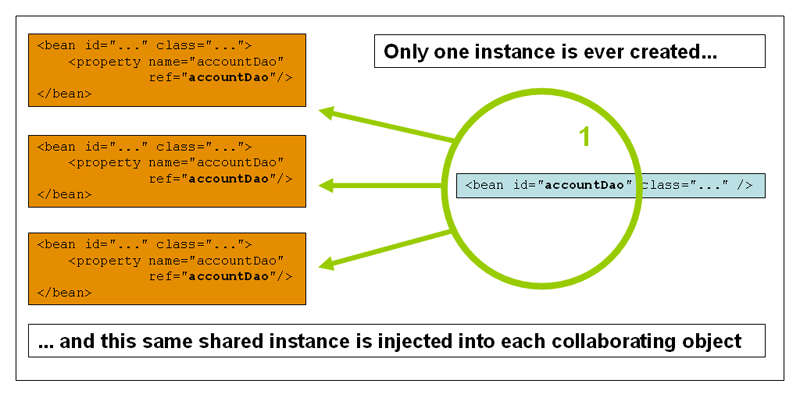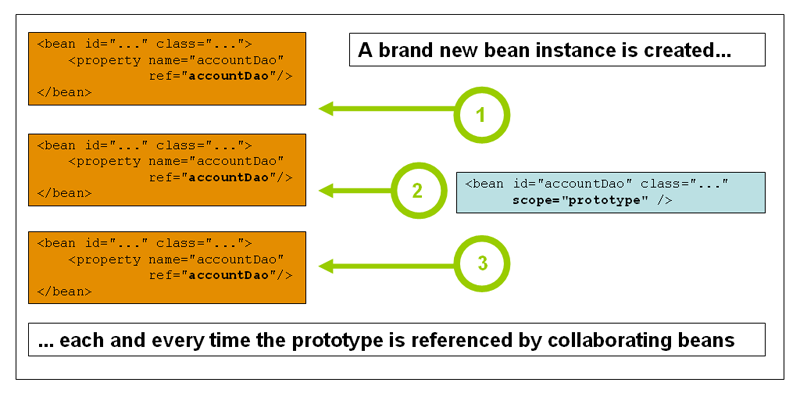spring学习之IOC容器2
bean的作用域
当我们定义一个bean时,你得为创建的很多bean实例提供一种方式。这个方式的定义很重要,它意味着你能为很多实例归并到一种方式里。
可以控制各个依赖和要被插入到从一特定bean定义创建的对象的配置值。
以下作用域支持开箱即用。您还可以创建一个自定义的范围。
singleton代表这在spring-ioc容器中只存在一个实例化的对象对应着bean。
prototype代表有多个不同的实例对象。
request代表每个http请求的生命周期都会新创建一个对象实例,只在基于spring-web的上下文才有效。ApplicationContext。
session代表每个http session的生命周期中都会新创建一个对象,只有存在spring-web的上下文中才有效,ApplicationContext。
application代表每个http整个应用期间都会只创建一个对象,只有存在spring-web的上下文中才有效,ApplicationContext。
web-socket代表每个web-socket生命周期期间都会只创建一个对象,只有存在spring-web的上下文中才有效,ApplicationContext。
singleton
只有一个实例被管理。
<bean id="accountService" class="com.foo.DefaultAccountService"/>
<!-- the following is equivalent, though redundant (singleton scope is the default) -->
<bean id="accountService" class="com.foo.DefaultAccountService" scope="singleton"/>prototype-scope
每次请求都会生成一个实例。
<bean id="accountService" class="com.foo.DefaultAccountService" scope="prototype"/>Request, session, application, and WebSocket scopes
开始的web配置
<web-app>
...
<listener>
<listener-class>
org.springframework.web.context.request.RequestContextListener
</listener-class>
</listener>
...
</web-app>另外,如果有与您的监听器设置问题,可以考虑使用Spring的RequestContextFilter两个。该过滤器映射取决于周围的Web应用程序的配置,所以你必须改变它为宜。
<web-app>
...
<filter>
<filter-name>requestContextFilter</filter-name>
<filter-class>org.springframework.web.filter.RequestContextFilter</filter-class>
</filter>
<filter-mapping>
<filter-name>requestContextFilter</filter-name>
<url-pattern>/*</url-pattern>
</filter-mapping>
...
</web-app>Request scope
xml配置如下
<bean id="loginAction" class="com.foo.LoginAction" scope="request"/>注解方式
@RequestScope
@Component
public class LoginAction {
// ...
}在下面的例子中的配置只有加了一行,而是要理解“为什么”以及“如何做”的背后是非常重要的。
<?xml version="1.0" encoding="UTF-8"?>
<beans xmlns="http://www.springframework.org/schema/beans"
xmlns:xsi="http://www.w3.org/2001/XMLSchema-instance"
xmlns:aop="http://www.springframework.org/schema/aop"
xsi:schemaLocation="http://www.springframework.org/schema/beans
http://www.springframework.org/schema/beans/spring-beans.xsd
http://www.springframework.org/schema/aop
http://www.springframework.org/schema/aop/spring-aop.xsd">
<!-- an HTTP Session-scoped bean exposed as a proxy -->
<bean id="userPreferences" class="com.foo.UserPreferences" scope="session">
<!-- instructs the container to proxy the surrounding bean -->
<aop:scoped-proxy/>
</bean>
<!-- a singleton-scoped bean injected with a proxy to the above bean -->
<bean id="userService" class="com.foo.SimpleUserService">
<!-- a reference to the proxied userPreferences bean -->
<property name="userPreferences" ref="userPreferences"/>
</bean>
</beans>为什么在注入bean scope在request,session,自定义的scope时,在配置中需要加入aop:scoped-proxy?
默认情况下,当生成一个代理的bean时,自动的标记aop:scoped-proxy,一个cglib的代理被创建。



























 被折叠的 条评论
为什么被折叠?
被折叠的 条评论
为什么被折叠?








